In a world full of different dog breeds, the Kerry Blue Terrier stands out like a vibrant brushstroke on a canvas. With its unique blue-gray coat and a lively personality, this breed is a true gem.
But there's more to the Kerry Blue Terrier than just its striking appearance. This intelligent and independent dog has a rich history and a distinct set of characteristics that make it an intriguing choice for potential pet owners.
From its origins as a working terrier in Ireland to its adaptability in apartment living, there is much to discover about this fascinating breed. So, let's dive into the world of Kerry Blue Terriers and uncover the facts and characteristics that make them truly special.
Key Takeaways
- Kerry Blue Terriers are hard-working, independent, and athletic dogs that require plenty of exercise, both mental and physical.
- Early socialization is crucial for a well-rounded adult Kerry Blue Terrier, and enrolling them in a puppy kindergarten class and exposing them to various experiences can help polish their social skills.
- Kerry Blue Terriers are prone to certain health conditions, so obtaining health clearances for parents from reputable breeders is important. Regular exercise, training, and grooming are also necessary for their well-being.
- Kerry Blue Terriers can adapt well to apartment living as long as they receive enough exercise. They have a moderate sensitivity level and can handle a noisy and chaotic household. However, it is important to prioritize qualities such as being quiet, low-energy, calm indoors, and well-mannered when selecting a dog for an apartment.
Characteristics and Temperament
Kerry Blue Terriers are known for their hard-working nature, independent spirit, and athleticism. These dogs aren't afraid to roll up their sleeves and get to work. Whether it's hunting small game, guarding their territory, or participating in dog sports, Kerry Blues are always up for a challenge.
Their independent nature makes them self-reliant and capable of making decisions on their own. However, this independence can also lead to stubbornness, so consistent and firm training is necessary.
With their high energy levels, Kerry Blues require plenty of exercise to keep them happy and healthy. They thrive in active households where they can engage in vigorous activities such as running, playing, and exploring.
Health and Care
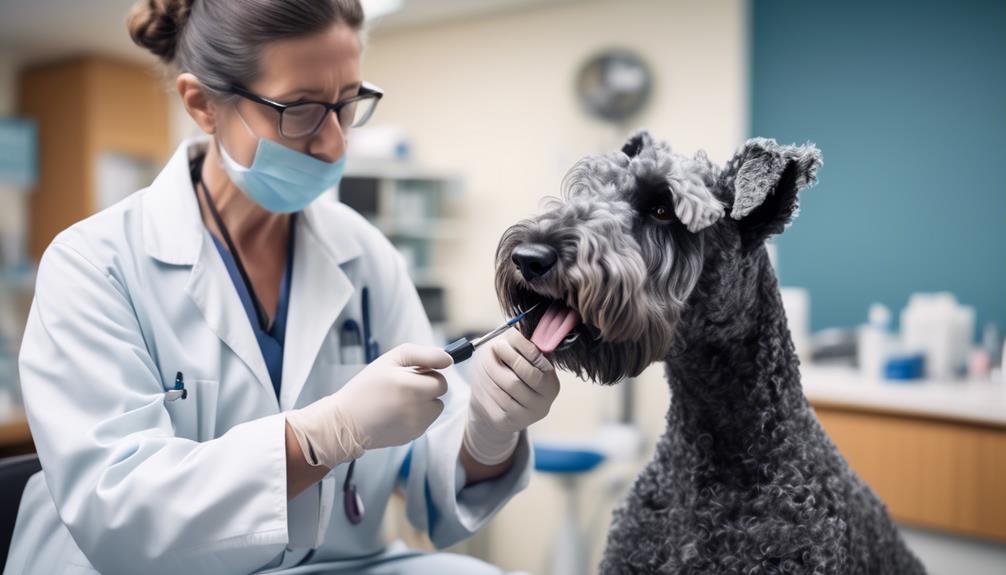
After discussing the characteristics and temperament of Kerry Blue Terriers, it's important to address their health and care needs. Here are four key points to consider when it comes to the health and care of Kerry Blue Terriers:
- Regular health check-ups: Kerry Blue Terriers are prone to certain health conditions, so it's important to schedule regular visits to the vet. Health clearances for parents should be obtained from reputable breeders to ensure a healthy lineage.
- Exercise and mental stimulation: Kerry Blue Terriers require plenty of exercise to maintain their muscle tone and mental alertness. Daily walks are necessary, even in inclement weather. In addition to physical exercise, providing mental stimulation through training and socialization is essential.
- Grooming: Regular grooming is necessary to maintain the Kerry Blue Terrier's unique coat and prevent matting. This includes brushing their coat, trimming their hair, and cleaning their ears and teeth.
- Proper nutrition: Providing a balanced diet that meets the nutritional needs of Kerry Blue Terriers is crucial for their overall health and well-being. Consult with a veterinarian to determine the appropriate diet and feeding schedule for your dog.
Size and Personality
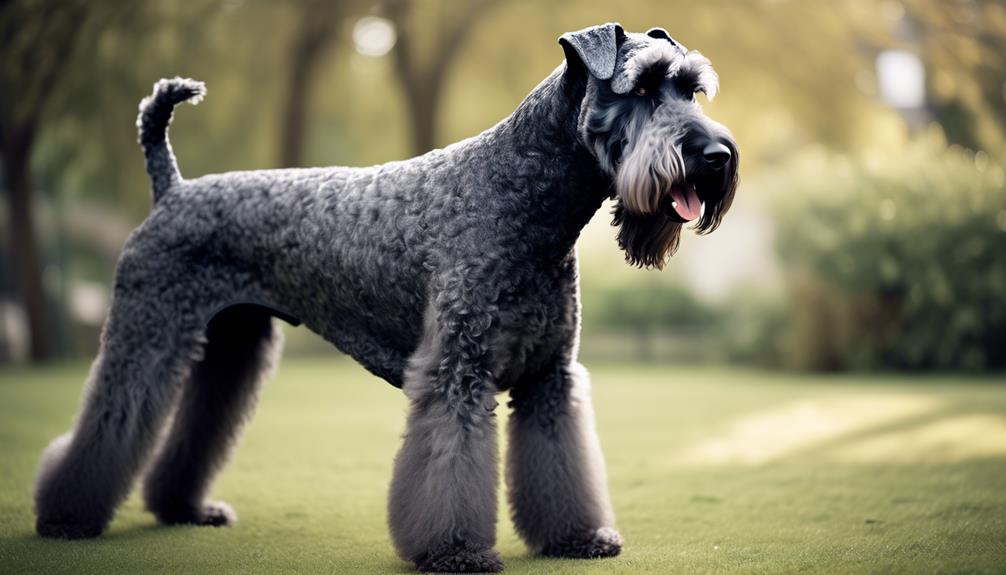
The size and personality of Kerry Blue Terriers make them a unique and captivating breed. Males typically stand 18 to 19.5 inches tall and weigh between 33 to 40 pounds, while females stand 17.5 to 19 inches tall and weigh the same.
With their medium-sized build, Kerry Blue Terriers are known for their good-naturedness with people of all ages. However, they can be prone to dog aggression, especially if they're intact. Proper socialization and training can help prevent dog aggression.
These dogs are loyal and affectionate towards their family but require a strong-willed owner to show consistent leadership.
History and Highlights
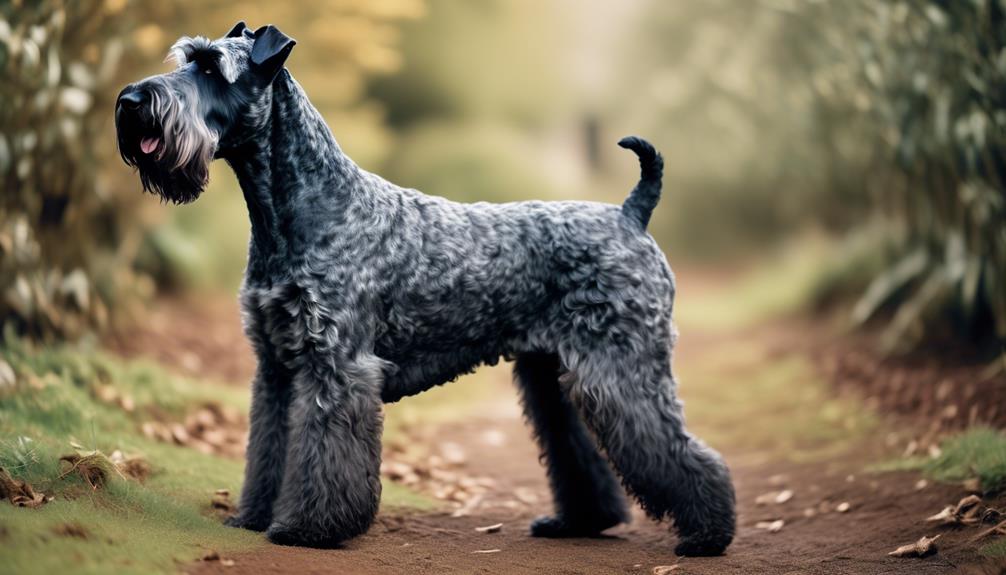
With their captivating size and good-natured personality, Kerry Blue Terriers have a rich history and numerous highlights that showcase their unique charm. Here are four key points about the history and highlights of the Kerry Blue Terrier:
- Origin in County Kerry, Ireland: Kerry Blue Terriers originated in County Kerry, Ireland, where they were used as working terriers. They hunted small game and birds, killed rodents, and guarded their homestead.
- Recognition and Nickname: The breed was recognized by the Kennel Club and the American Kennel Club. Early Kerry Blue Terriers were bred for aggressiveness, earning the nickname Blue Devil.
- Michael Collins and National Dog of Ireland: Michael Collins, an Irish patriot, introduced legislation to name the Kerry Blue the National Dog of Ireland, highlighting their importance in Irish culture.
- Feisty and Active Nature: Kerry Blue Terriers are quick learners but can be strong-willed. They're friendly towards people but have a distaste for other dogs. They're also known for their feisty nature, enjoying activities like digging, chasing, chewing, and barking. Their active nature requires plenty of exercise to keep them happy and healthy.
Adaptability and Sensitivity Level
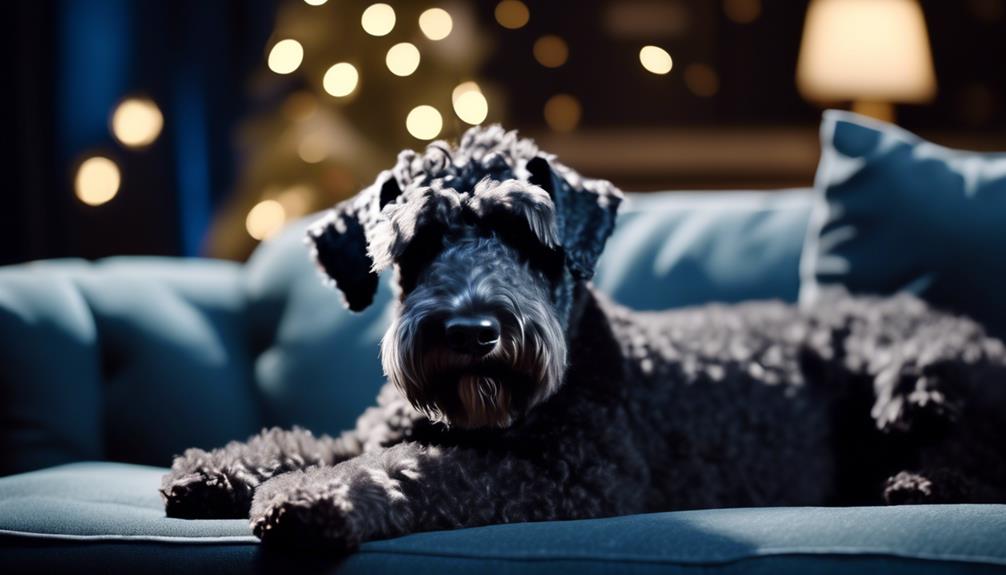
Adapting well to various living situations, the Kerry Blue Terrier is a versatile and resilient breed. They can adapt well to apartment living as long as they receive enough exercise. With a moderate activity level, they can be content with indoor playtime or brisk walks. It is important to choose a Kerry Blue Terrier that is quiet and well-behaved in shared spaces. They can also thrive in high-rise settings if they are trained to be calm and polite towards other residents. Size is not the only factor to consider when choosing a dog for an apartment. Some larger breeds can adapt well to apartment living with lower energy levels, while certain small dog breeds with higher energy levels can still thrive in apartments. The Kerry Blue Terrier has a moderate sensitivity level, able to handle a noisy and chaotic household. They are tolerant and resilient, making them suitable for families with young kids or a hectic lifestyle.
| Adaptability | Sensitivity Level |
|---|---|
| Highly adaptable | Moderate sensitivity |
| Can thrive in apartments | Can handle a noisy and chaotic household |
| Moderate activity level | Tolerant and resilient |
| Quiet and well-behaved in shared spaces | Suitable for families with young kids or a hectic lifestyle |
Exercise and Mental Stimulation
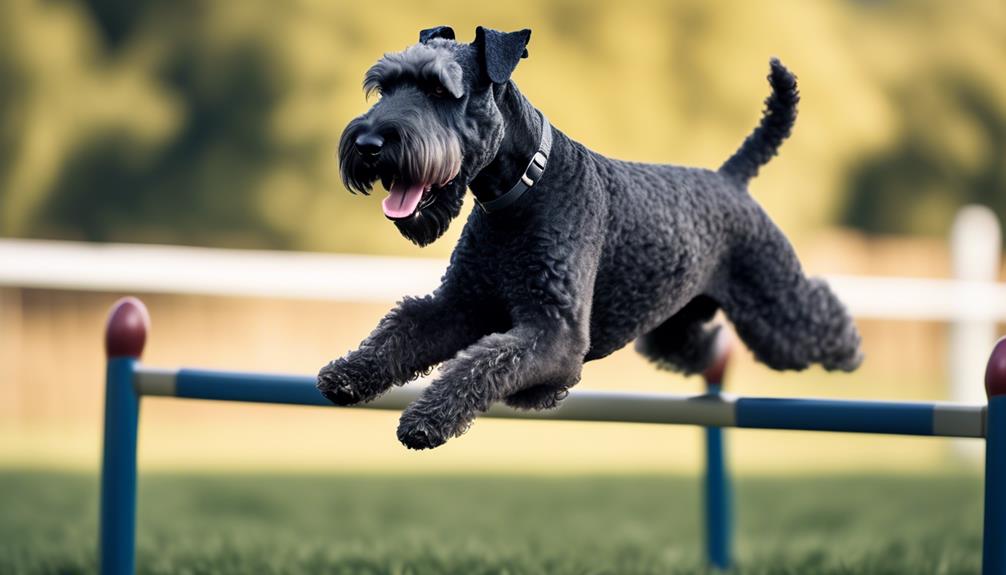
To ensure their overall well-being, Kerry Blue Terriers require regular exercise and mental stimulation. Here are four ways to provide them with the physical and mental activities they need:
1) Daily walks: Kerry Blue Terriers should be taken for daily walks to maintain their muscle tone and mental alertness. Even in inclement weather, it's important to take them out for their exercise.
2) Training sessions: Incorporate training sessions into their routine to provide mental stimulation. Kerry Blue Terriers are quick learners but can be strong-willed, so consistent and firm but loving handling is necessary.
3) Puzzle toys: Use puzzle toys to challenge their problem-solving skills. These toys can keep them entertained and mentally stimulated, preventing boredom.
4) Playtime with other dogs: Socialize Kerry Blue Terriers with other dogs to provide them with both physical exercise and mental stimulation. It's important to monitor their interactions and ensure they're well-behaved.
Socialization and Training
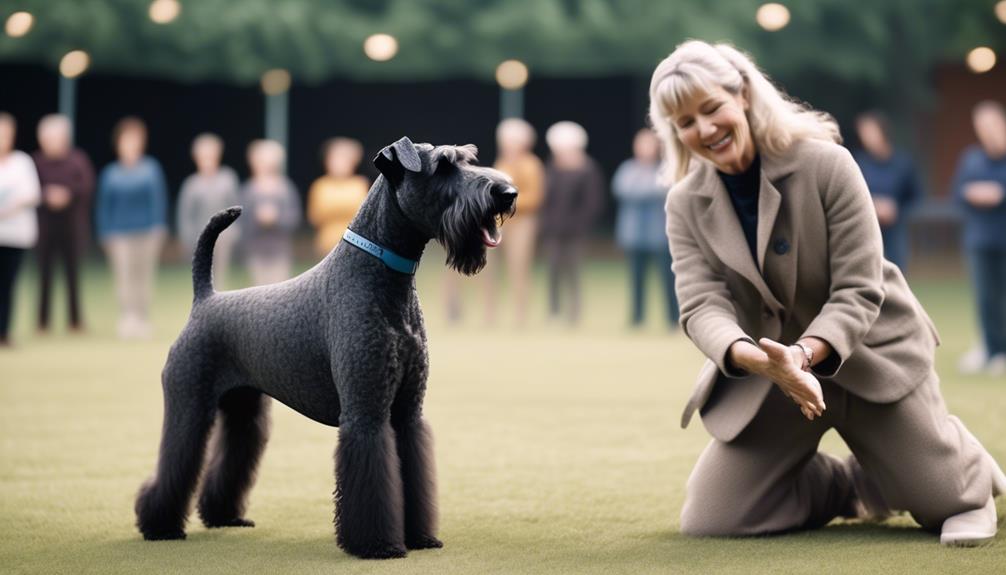
Socializing and training a Kerry Blue Terrier is crucial for their development and well-rounded behavior. These dogs have an independent nature and can be prone to dog aggression if not properly socialized. Starting with puppy classes, it's important to expose them to different places, people, and experiences to polish their social skills.
Firm but loving handling is needed to guide their strong-willed nature. Training should focus on consistency and positive reinforcement to keep them engaged and motivated. With their quick learning abilities, Kerry Blue Terriers can be taught various commands and tricks.
Additionally, early socialization plays a vital role in shaping their temperament and behavior as adult dogs. By providing them with the necessary training and socialization, Kerry Blue Terriers can become well-behaved and well-adjusted companions.
Grooming and Coat Care
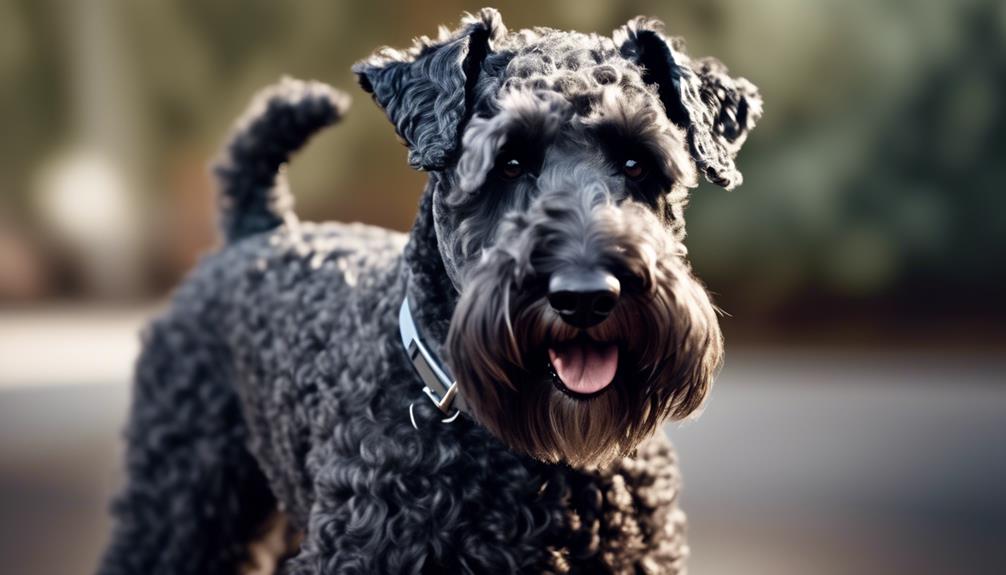
After focusing on the importance of socialization and training, let's now turn our attention to the grooming and coat care needs of the Kerry Blue Terrier.
Grooming and Coat Care:
- Regular brushing: Kerry Blue Terriers have a dense, curly coat that requires regular brushing to prevent matting and tangling. Brushing should be done at least once a week to keep their coat healthy and free of debris.
- Professional grooming: Due to their unique coat texture, Kerry Blue Terriers should be professionally groomed every six to eight weeks. This includes trimming their hair, shaping their beard, and keeping their nails trimmed.
- Bathing: Kerry Blue Terriers should be bathed every three to four weeks to keep their coat clean and free of dirt. Use a mild dog shampoo and be sure to thoroughly rinse their coat to prevent any residue.
- Ear care: The Kerry Blue Terrier's floppy ears are prone to ear infections, so regular cleaning is essential. Use a veterinarian-approved ear cleaner and gently wipe their ears to remove any debris or excess wax.
Common Health Conditions

Kerry Blue Terriers are prone to certain health conditions, which can affect their overall well-being. While not all dogs of this breed will develop these conditions, it's important for owners to be aware of them.
Some common health issues that Kerry Blue Terriers may face include hip dysplasia, elbow dysplasia, hypothyroidism, von Willebrand's disease, thrombopathia, entropion, skin cysts, cancer, and keratoses. Eye conditions such as cataracts, dry eye, and pigmentary keratitis can also occur.
Regular exercise is necessary to maintain their muscle tone and mental alertness. Daily walks are a must, even in inclement weather. Training and socialization are essential, starting with puppy classes. Firm yet loving handling is required due to their independent nature.
Regular grooming is necessary to maintain their coat and prevent matting.
Potential Aggression and Prevention

Owners of Kerry Blue Terriers should be aware of potential aggression in this breed and take proactive measures to prevent it. To help ensure a well-behaved and non-aggressive Kerry Blue Terrier, consider the following tips:
- Early Socialization: Introduce your Kerry Blue Terrier to different people, animals, and environments from a young age. This will help them develop good social skills and reduce the likelihood of aggressive behavior.
- Proper Training: Consistent and positive training methods are crucial for Kerry Blue Terriers. Teach them basic obedience commands and reinforce good behavior. This will establish you as the pack leader and reduce the chances of aggression.
- Neutering/Spaying: Consider having your Kerry Blue Terrier neutered or spayed. This can help reduce aggression, especially towards other dogs.
- Supervision and Monitoring: Always supervise interactions between your Kerry Blue Terrier and other animals or people, especially children. This will allow you to intervene if any signs of aggression arise and prevent any potential incidents.
Apartment Living and Adaptability

Living in an apartment can be suitable for Kerry Blue Terriers if they receive enough exercise and training. Despite their medium-sized build, Kerry Blue Terriers have a moderate activity level and can be content with indoor playtime or brisk walks. They can adapt well to small living spaces as long as they're given proper outlets for their energy.
It's important to choose a Kerry Blue Terrier that's quiet and well-behaved in shared spaces, and they can thrive in high-rise settings if they're trained to be calm and polite towards other residents. Size isn't the only factor to consider when choosing a dog for an apartment, as certain small dog breeds with higher energy levels can still thrive in apartments. Prioritizing qualities such as being quiet, low-energy, calm indoors, and well-mannered is crucial to ensure the comfort of neighbors.
Additionally, Kerry Blue Terriers have a moderate sensitivity level and can handle a noisy and chaotic household, making them adaptable to different living situations.
Frequently Asked Questions
Are Kerry Blue Terriers Good With Children?
Kerry Blue Terriers are good with children. They are known for their good-naturedness and loyalty towards their family. Proper socialization and training are important to ensure a positive interaction between the dog and children.
How Do Kerry Blue Terriers Get Along With Other Pets?
Kerry Blue Terriers can be prone to dog aggression and have a distaste for other dogs. Proper socialization and training are important to prevent aggression and help them get along with other pets.
What Is the Average Lifespan of a Kerry Blue Terrier?
The average lifespan of a Kerry Blue Terrier is around 12 to 15 years. They are a relatively healthy breed, but can be prone to certain health conditions, so regular veterinary care is important.
Do Kerry Blue Terriers Have Any Specific Dietary Requirements?
Kerry Blue Terriers do not have any specific dietary requirements. However, like all dogs, they should be fed a balanced diet that meets their nutritional needs. Consult with a veterinarian for guidance on the best diet for your Kerry Blue Terrier.
Are Kerry Blue Terriers Prone to Separation Anxiety?
Kerry Blue Terriers can be prone to separation anxiety if left alone for long periods of time. They are loyal and affectionate dogs that thrive on human companionship, so they may become anxious when separated from their owners.
What are the differences between Kerry Blue Terriers and Norwich Terriers?
The Norwich Terrier dog breed and the Kerry Blue Terrier dog breed are both terriers, but they have significant differences. The Norwich Terrier is smaller and has a stockier build, while the Kerry Blue Terrier is larger and has a more elegant appearance. Additionally, their coat colors and textures vary.
Conclusion
In conclusion, the Kerry Blue Terrier is a versatile and energetic breed that requires proper care and training to thrive. With their independent nature and medium-sized build, they make loyal and affectionate family pets.
However, they can be prone to dog aggression if not properly socialized and trained. Regular exercise, grooming, and consistent leadership are essential for their well-being.
With the right care, the Kerry Blue Terrier can adapt well to apartment living and bring joy to their owners' lives.




